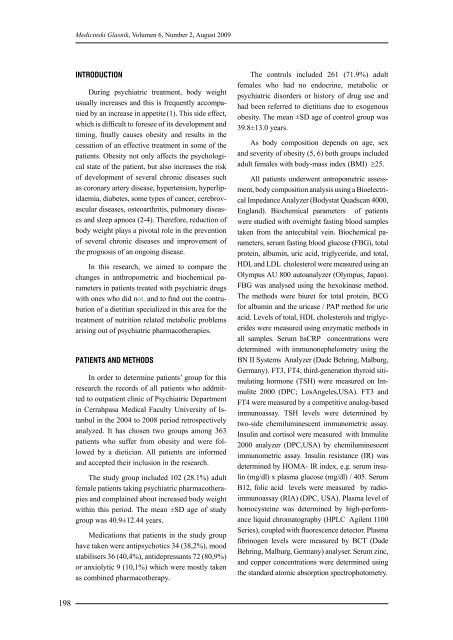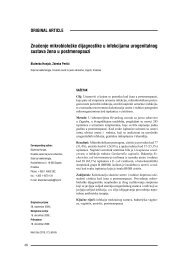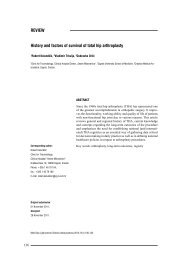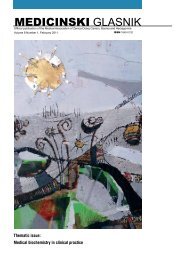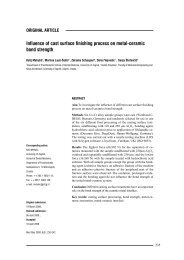MEDICINSKI GLASNIK
MEDICINSKI GLASNIK
MEDICINSKI GLASNIK
Create successful ePaper yourself
Turn your PDF publications into a flip-book with our unique Google optimized e-Paper software.
198<br />
Medicinski Glasnik, Volumen 6, Number 2, August 2009<br />
INTRODUCTION<br />
During psychiatric treatment, body weight<br />
usually increases and this is frequently accompanied<br />
by an increase in appetite (1). This side effect,<br />
which is difficult to foresee of its development and<br />
timing, finally causes obesity and results in the<br />
cessation of an effective treatment in some of the<br />
patients. Obesity not only affects the psychological<br />
state of the patient, but also increases the risk<br />
of development of several chronic diseases such<br />
as coronary artery disease, hypertension, hyperlipidaemia,<br />
diabetes, some types of cancer, cerebrovascular<br />
diseases, osteoarthritis, pulmonary diseases<br />
and sleep apnoea (2-4). Therefore, reduction of<br />
body weight plays a pivotal role in the prevention<br />
of several chronic diseases and improvement of<br />
the prognosis of an ongoing disease.<br />
In this research, we aimed to compare the<br />
changes in anthropometric and biochemical parameters<br />
in patients treated with psychiatric drugs<br />
with ones who did not, and to find out the contrubution<br />
of a dietitian specialized in this area for the<br />
treatment of nutrition related metabolic problems<br />
arising out of psychiatric pharmacotherapies.<br />
PATIENTS AND METHODS<br />
In order to determine patients’ group for this<br />
research the records of all patients who addmitted<br />
to outpatient clinic of Psychiatric Department<br />
in Cerrahpasa Medical Faculty University of Istanbul<br />
in the 2004 to 2008 period retrospectively<br />
analyzed. It has chosen two groups among 363<br />
patients who suffer from obesity and were followed<br />
by a dietician. All patients are informed<br />
and accepted their inclusion in the research.<br />
The study group included 102 (28.1%) adult<br />
female patients taking psychiatric pharmacotherapies<br />
and complained about increased body weight<br />
within this period. The mean ±SD age of study<br />
group was 40.9±12.44 years.<br />
Medications that patients in the study group<br />
have taken were antipsychotics 34 (38,2%), mood<br />
stabilisers 36 (40,4%), antidepressants 72 (80,9%)<br />
or anxiolytic 9 (10,1%) which were mostly taken<br />
as combined pharmacotherapy.<br />
The controls included 261 (71.9%) adult<br />
females who had no endocrine, metabolic or<br />
psychiatric disorders or history of drug use and<br />
had been referred to dietitians due to exogenous<br />
obesity. The mean ±SD age of control group was<br />
39.8±13.0 years.<br />
As body composition depends on age, sex<br />
and severity of obesity (5, 6) both groups included<br />
adult females with body-mass index (BMI) ≥25.<br />
All patients underwent antropometric assessment,<br />
body composition analysis using a Bioelectrical<br />
Impedance Analyzer (Bodystat Quadscan 4000,<br />
England). Biochemical parameters of patients<br />
were studied with overnight fasting blood samples<br />
taken from the antecubital vein. Biochemical parameters,<br />
serum fasting blood glucose (FBG), total<br />
protein, albumin, uric acid, triglyceride, and total,<br />
HDL and LDL cholesterol were measured using an<br />
Olympus AU 800 autoanalyzer (Olympus, Japan).<br />
FBG was analysed using the hexokinase method.<br />
The methods were biuret for total protein, BCG<br />
for albumin and the uricase / PAP method for uric<br />
acid. Levels of total, HDL cholesterols and triglycerides<br />
were measured using enzymatic methods in<br />
all samples. Serum hsCRP concentrations were<br />
determined with immunonephelometry using the<br />
BN II Systems Analyzer (Dade Behring, Malburg,<br />
Germany). FT3, FT4, third-generation thyroid sitimulating<br />
hormone (TSH) were measured on Immulite<br />
2000 (DPC; LosAngeles,USA). FT3 and<br />
FT4 were measured by a competitive analog-based<br />
immunoassay. TSH levels were determined by<br />
two-side chemiluminescent immunometric assay.<br />
Insulin and cortisol were measured with Immulite<br />
2000 analyzer (DPC,USA) by chemiluminescent<br />
immunometric assay. Insulin resistance (IR) was<br />
determined by HOMA- IR index, e.g. serum insulin<br />
(mg/dl) x plasma glucose (mg/dl) / 405. Serum<br />
B12, folic acid levels were measured by radioimmunoassay<br />
(RIA) (DPC, USA). Plasma level of<br />
homocysteine was determined by high-performance<br />
liquid chromatography (HPLC Agilent 1100<br />
Series), coupled with fluorescence detector. Plasma<br />
fibrinogen levels were measured by BCT (Dade<br />
Behring, Malburg, Germany) analyser. Serum zinc,<br />
and copper concentrations were determined using<br />
the standard atomic absorption spectrophotometry.


